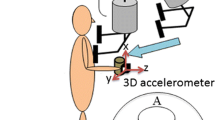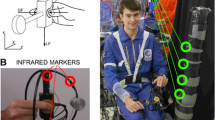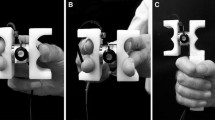Summary
Small objects were lifted from a table, held in the air, and replaced using the precision grip between the index finger and thumb. The adaptation of motor commands to variations in the object's weight and sensori-motor mechanisms responsible for optimum performance of the transition between the various phases of the task were examined. The lifting movement involved mainly a flexion of the elbow joint. The grip force, the load force (vertical lifting force) and the vertical position were measured. Electromyographic activity (e.m.g.) was recorded from four antagonist pairs of hand/arm muscles primarily influencing the grip force or the load force. In the lifting series with constant weight, the force development was adequately programmed for the current weight during the loading phase (i.e. the phase of parallel increase in the load and grip forces during isometric conditions before the lift-off). The grip and load force rate trajectories were mainly single-peaked, bell-shaped and roughly proportional to the final force. In the lifting series with unexpected weight changes between lifts, it was established that these force rate profiles were programmed on the basis of the previous weight. Consequently, with lifts programmed for a lighter weight the object did not move at the end of the continuous force increase. Then the forces increased in a discontinous fashion until the force of gravity was overcome. With lifts programmed for a heavier weight, the high load and grip force rates at the moment the load force overcame the force of gravity caused a pronounced positional overshoot and a high grip force peak, respectively. In these conditions the erroneous programmed commands were automatically terminated by somatosensory signals elicited by the start of the movement. A similar triggering by somatosensory information applied to the release of programmed motor commands accounting for the unloading phase (i.e. the parallel decrease in the grip and load forces after the object contacted the table following its replacement). These commands were always adequately programmed for the weight.
Similar content being viewed by others
References
Abbruzzese G, Ratto S, Favale E, Abbruzzese M (1981) Proprioceptive modulation of somatosensory evoked potentials during active or passive finger movements in man. J Neurol Neurosurg Psychiat 44: 942–949
Abend W, Bizzi E, Morasso P (1982) Human arm trajectory formation. Brain 105: 331–348
Basmajian JV (1978) Muscles alive. Their function revealed by electromyography. The William & Wilkins Company, Baltimore
Bizzi E, Abend W (1983) Posture control of trajectory formation in single- and multi-joint arm movements. In: Desmedt RE (ed) Motor control mechanisms in health and disease. Advances in neurology, Vol 39. Raven Press, New York, pp 31–45
Brooks VB (1979) Motor programs revisited. In: Talbott RE, Humphrey DR (eds) Posture and movement. Raven Press, New York, pp 13–49
Brooks VB (1984) How are “move” and “hold” programs matched? In: Bloedel et al. (eds) Cerebellar functions. Springer, Berlin, pp 1–23
Cole KJ, Abbs JH (1987) Kinematic and electromyographic responses to perturbation of a rapid grasp. J Neurophysiol 57 (in press)
Cole KJ, Gracco VL, Abbs JH (1984) Autogenic and nonautogenic sensorimotor actions in the control of multiarticulate hand movements. Exp Brain Res 56: 582–585
Darton K, Lippold OCJ, Shahani M, Shahani U (1985) Long-latency spinal reflexes in humans. J Neurophysiol 53: 1604–1618
Denny-Brown D (1966) The cerebral control of movement. The Liverpool Univ Press, Liverpool
Evarts EV, Tanji J (1974) Gating of motor cortex reflexes by prior instruction. Brain Res 71: 479–494
Garnett R, Stephens JA (1980) The reflex responses of single motor units in human first dorsal interosseous muscle following cutaneous afferent stimulation. J Physiol (Lond) 303: 351–364
Garnett R, Stephens JA (1981) Changes in the recruitment threshold of motor units produced by cutaneous stimulation in man. J Physiol (Lond) 311: 463–473
Ghez C, Vicario D, Martin JH, Yumiya H (1983) Sensory motor processing of target movements in motor cortex. In: Desmedt JE (ed) Motor control mechanisms in health and disease. Raven Press, New York, pp 61–92
Gordon J, Ghez C (1984) EMG patterns in antagonist muscles during isometric contraction in man. Exp Brain Res 55: 167–171
Gracco VL, Abbs JH (1985) Dynamic control of the perioral system during speech: kinematic analyses of autogenic and nonautogenic sensorimotor processes. J Neurophysiol 54: 418–432
Horak FB, Nashner LM (1986) Central programming of postural movements: adaptation to altered support surface configurations. J Neurophysiol 55: 1369–1381
Houk JC, Rymer WZ (1981) Neural control of muscle length and tension. In: Brooks VB (ed) Handbook of physiology. The nervous system, Vol 2. Am Physiol Soc, Bethesda, MD, pp 257–323
Johansson RS, Westling G (1984a) Influences of cutaneous sensory input on the motor coordination during precision manipulation. In: von Euler C, Franzen O, Lindblom U, Ottoson D (eds) Somatosensory mechanisms. Macmillan Press, London, pp 249–260
Johansson RS, Westling G (1984b) Roles of glabrous skin receptors and sensorimotor memory in automatic control of precision grip when lifting rougher or more slippery objects. Exp Brain Res 56: 550–564
Johansson RS, Westling G (1987) Signals in tactile afferents from the fingers eliciting adaptive motor responses during precision grip. Exp Brain Res 66: 141–154
Johansson RS, Westling G (1988) Programmed and triggered actions to rapid load changes during precision grip. Exp Brain Res 71: 72–86
Long CH, Conrad PW, Hall EA, Furler SL (1970) Intrinsic and extrinsic muscle control of the hand in power grip and precision handling. J Bone Joint Surg 52A: 853–867
Marsden CD, Merton PA, Morton HB (1981) Human postural responses. Brain 104: 513–534
Marsden CD, Merton PA, Morton HB (1985) New observations on the human stretch reflex. J Physiol (Lond) 360: 51P
McCloskey DI (1974) Muscular and cutaneous mechanisms in the estimation of the weights of grasped objects. Neuropsychologia 12: 513–520
Muir RB (1985) Small hand muscles in precision grip: a corticospinal prerogative. In: Goodwin AW, Darian-Smith I (eds) Hand function and the neocortex. Springer, Berlin, pp 155–174
Nelson RJ (1985) Sensorimotor cortex responses to vibrotactile stimuli during initiation and execution of hand movement. In: Goodwin AW, Darian-Smith I (eds) Hand function and the neocortex. Springer, Berlin, pp 59–76
Patton NJ, Mortensen OA (1971) An electromyographic study of reciprocal activity of muscles. Anat Rec 170: 255–268
Phillips CG, Porter R (1977) Corticospinal neurones. Academic Press, London
Rack PMH (1981) Limitations of somatosensory feedback in control of posture and movements. In: Brooks VB (ed) Handbook of physiology. The nervous system, Vol 2. Am Physiol Soc, Bethesda, MD, pp 229–256
Rasch PJ, Burke PK (1974) Kinesiology and applied anatomy. Lea & Febiger, Philadelphia
Ross H (1969) When is a weight illusory? Q J Exp Psychol 21: 346–355
Smith AM (1981) The coactivation of antagonist muscles. Can J Physiol Pharmacol 59: 733–747
Vallbo ÅB (1985) Proprioceptive activity from human finger muscles. In: Barnes WJP, Gladden MH (eds) Feedback and motor control in invertebrates and vertebrates. Croom Helm Ltd, London, pp 411–430
Welford AT (1976) Skilled performance: perceptual and motor skills. Scott Foresman and Company, Glenview, Ill
Westling G, Johansson RS (1987) Responses in glabrous skin mechanoreceptors during precision grip in humans. Exp Brain Res 66: 128–140
Author information
Authors and Affiliations
Rights and permissions
About this article
Cite this article
Johansson, R.S., Westling, G. Coordinated isometric muscle commands adequately and erroneously programmed for the weight during lifting task with precision grip. Exp Brain Res 71, 59–71 (1988). https://doi.org/10.1007/BF00247522
Received:
Accepted:
Issue Date:
DOI: https://doi.org/10.1007/BF00247522




